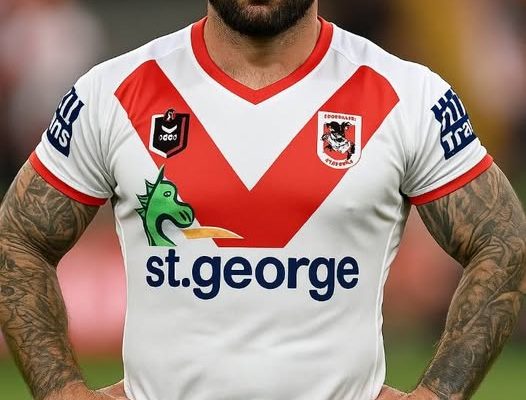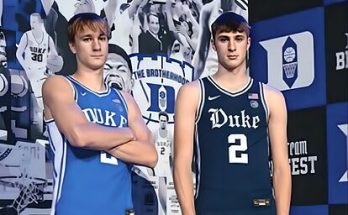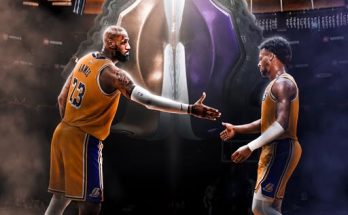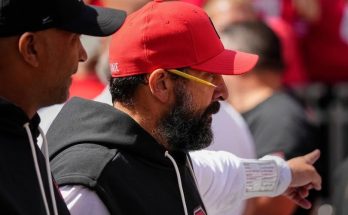The rugby league world was taken by surprise with the news that Adam Reynolds, one of the sport’s most accomplished and celebrated halfbacks, has signed a $1.2 million deal with the St George Illawarra Dragons. This high-profile signing marks a stunning exit from the Brisbane Broncos, a club where Reynolds was expected to make a significant impact. The move not only shakes up the dynamics within the National Rugby League (NRL) but also offers a fascinating study in player career progression, contract negotiations, and strategic team building in professional rugby league.
Adam Reynolds has long been a figure synonymous with precision, leadership, and calmness under pressure on the field. His reputation was forged during his extensive tenure at the South Sydney Rabbitohs, where he became the club’s all-time leading point scorer and a fan favorite for his clutch performances and tactical kicking game. Reynolds’s journey through the NRL highlights not just his individual brilliance but also the broader evolution of the halfback role in modern rugby league. Halfbacks today are not merely organizers or distributors; they are the architects of the team’s attacking play, crucial decision-makers, and often the emotional anchors for their squads. Reynolds embodied this transformation with his intelligent game management, composure in tight moments, and ability to execute goal-kicking duties with remarkable consistency.
After leaving the Rabbitohs, Reynolds’s move to the Brisbane Broncos was seen as a promising new chapter, both for the player and the club. The Broncos, a team with a rich history and passionate supporter base, had been rebuilding and looking to re-establish themselves as contenders in the fiercely competitive NRL. Bringing in a seasoned playmaker like Reynolds was a statement of intent, signaling the club’s desire to blend experience with youth and tactical nous. However, despite the initial optimism, Reynolds’s time at Brisbane didn’t unfold as many anticipated. Various factors, including team dynamics, injury setbacks, and tactical mismatches, appeared to limit his influence on the field. This reality perhaps set the stage for his surprising move to the Dragons.
The St George Illawarra Dragons’ acquisition of Reynolds on a $1.2 million deal is significant not only because of the player’s pedigree but also due to the implications it carries for the Dragons’ immediate and long-term plans. The Dragons have been striving to reclaim their place among the NRL’s elite, and securing a player of Reynolds’s caliber suggests a clear push to strengthen their spine, especially in the pivotal halfback position. This move is emblematic of the club’s strategic vision to blend proven leadership and experience with their existing talent pool, potentially accelerating their rise up the ladder in coming seasons.
Financially, the $1.2 million contract speaks volumes about the market value placed on elite halfbacks in the current rugby league landscape. Player salaries in the NRL have been trending upwards, reflecting the increasing professionalism, commercial opportunities, and the growing stakes in winning premierships. For the Dragons, this investment underscores a willingness to commit significant resources to secure top-tier talent. It also highlights the competitive nature of the player market, where clubs must balance budgets while trying to outmaneuver rivals in attracting marquee players.
From a broader perspective, Reynolds’s switch highlights key trends in player movement and contract negotiations within the NRL. Rugby league careers, often relatively short due to the physical demands of the sport, necessitate careful management and strategic decision-making by players and their agents. Reynolds’s move can be understood in the context of seeking an environment where his skills are best utilized and appreciated, while also maximizing financial security in the latter stages of his career. This decision-making process is crucial for players who want to leave a lasting legacy while also preparing for life beyond the field.
The Broncos’ perspective on this departure must also be examined. Losing a player of Reynolds’s experience is a blow, but it also opens opportunities for emerging talent within the squad to step up. The Broncos have a history of developing promising players, and this transition may catalyze a renewed focus on nurturing the next generation of playmakers. Additionally, the club’s salary cap management and roster decisions will be closely watched as they adjust to this unexpected exit.
On the Dragons’ side, integrating Reynolds into the team structure will be a fascinating challenge. The club will need to ensure that his playing style, leadership, and strategic approach blend effectively with the existing squad dynamics and coaching philosophy. Successful integration could transform the Dragons into a more cohesive and threatening unit on the field, elevating their competitiveness in a league where margins between victory and defeat are razor-thin.
This transfer also sheds light on the broader theme of adaptability and resilience in professional sports. For Reynolds, changing clubs, especially late in a career, demands a high degree of adaptability—not just in learning new systems and tactics but in building relationships within a new team culture. It requires mental toughness to embrace change and a growth mindset to continue performing at an elite level under different coaching and team environments.
Moreover, the move provides a valuable case study in the strategic considerations that clubs undertake when pursuing player signings. Factors such as team needs, salary cap constraints, player leadership qualities, and potential commercial benefits all play a part. High-profile signings can boost club morale, attract sponsors, and engage fans, creating ripple effects beyond just on-field performance.
For fans and analysts, Reynolds’s transfer is a moment to reflect on the changing dynamics of the NRL. The league is evolving with greater player mobility, higher stakes in terms of financial investment, and more sophisticated tactical approaches. The ability to adapt to these changes is critical for both players and clubs aiming to sustain success.
In conclusion, Adam Reynolds’s $1.2 million deal with the St George Illawarra Dragons following his unexpected exit from the Brisbane Broncos marks a significant event in the rugby league calendar. It illustrates the intricate interplay of talent, opportunity, and strategy that defines professional sports today. Reynolds’s career, marked by excellence and leadership, will now enter a new chapter with the Dragons, offering both the player and the club a chance to achieve new heights. This move enriches the narrative of the NRL, reminding fans and stakeholders alike of the ever-shifting landscape of professional rugby league and the exciting developments that continue to shape the sport’s future.



